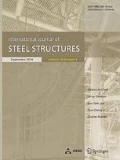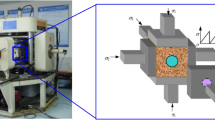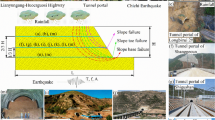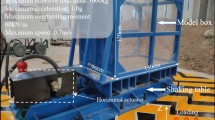Abstract
Seismic fragility analysis was performed for API X65, a type of buried gas pipeline that is widely used in Korea. For this purpose, nonlinear time-history analyses were carried out using 15 different analytical models of the pipeline, which represent variations of modeling parameters. The nonlinear Winkler approach was adopted to simulate the soil-pipeline interaction during an earthquake loading. A set of 12 recorded ground motions were selected for the time-history analyses and scaled to represent a range of earthquake intensity levels. Then, fragility functions were developed with respect to the damage states, which are defined in terms of the maximum axial strain of the pipeline. The parameters under consideration for subsequent seismic fragility analyses are the soil conditions, boundary conditions, burial depth, and type of pipeline. Comparative analyses revealed that the first three parameters, most notably the soil conditions, influence the fragility curves, but the last parameter negligibly affects the fragility curves. It is concluded in short that this study is promising to give a useful insight for a rapid seismic performance evaluation of a buried gas pipeline based on nonlinear and fragility analyses.
Similar content being viewed by others
References
Ang, A. H. S. and Tang, W. H. (1984). Probability concept in engineering planning and design II. John Wiley and Sons, New York, pp.333–346.
APEC (2003). Seismic codes and standards of energy supply system. Report for Asia-Pacific Economic Cooperation Energy Working Group, Energy Commission Ministry of Economic Affairs, Chinese Taipei, pp.54–60.
ASCE (2001). Guidelines for the design of buried steel pipe. American Lifelines Alliance.
ASCE-TCLEE (1991). Seismic loss estimation for a hypothetical water system. Monograph No.2, C.E. Taylor, C. E. (eds), Technical Council on Lifeline Earthquake Engineering (TCLEE) of the American Society of Civil Engineers, ASCE.
Chen, W. W., Shih, B. J., Wu, C. W., and Chen, Y. C. (2000). “Natural gas pipeline system damages in the Ji-Ji earthquake (The City of Nantou).” Proc. Sixth International Conference on Seismic Zonation, Palm Spring, CA.
Dames and Moore, Inc. (1999). “The Loma Prieta earthquake: Impact of lifeline systems.” Journal of Disaster Recovery, 3(2), pp. 8.
Datta, T. K. (1999). “Seismic response of buried pipelines: a state-of-the-art review.” Nuclear Engineering and Design, 192(2–3), pp.271–284, doi: 10.1016/S0029-5493(99)00113-2.
Eguchi, R. T. (1983). “Seismic vulnerability models for underground pipes.” Proc. Earthquake Behaviour and Safety of Oil and Gas Storage Facilities, Buried Pipelines and Equipment, ASME, New York, pp.368–373.
Elnashai, A. S., Papanikolaou, V., and Lee, D. H. (2001). ZeusNL-A program for inelastic dynamic analysis of structures. MAE Center, University of Illinois at Urbana-Champaign.
EQE International (1995). The January 17, 1995 Kobe Earthquake: An EQE Summary Report, EQE International.
Hamada, M. (1991). “Estimation of earthquake damage to lifeline systems in Japan.” Proc. 3rd Japan-US Workshop on Earthquake Engineering Design of Lifeline Facilities and Countermeasures for Soil Liquefaction, Technical Report NCEER-91-0001, National Center for Earthquake Engineering Research, San Francisco, USA.
Hwang, H. and Lin, H. (1997). GIS-based evaluation of seismic performance of water delivery systems. Technical Report prepared for CERI, University of Memphis.
Isoyama, R. and Katayama, T. (1982). Reliability evaluation of water supply systems during earthquakes. Report of the Institute of Industrial Science, Vol. 30, No. 1 (Serial No. 194), The University of Tokyo.
Jeon, S. S. and O’Rourke, T. D. (2005). “Northridge earthquake effects on pipelines and residential buildings.” Bulletin of the Seismological Society of America, 95(1), pp.294–318.
Katayama, T., Kubo, K., and Sato, N. (1975). “Earthquake damage to water and gas distribution systems.” Proc. U.S. National Conference on Earthquake Engineering, EERI, Oakland, California, pp.396–405.
Lee, D. H., Kim, B. H., Lee, H., and Kong, J. S. (2009). “Seismic behavior of a buried gas pipeline under earthquake excitations.” Engineering Structures, 31(5), pp.1011–1023, doi: 10.1016/j.engstruct.2008.12.012.
Mashaly, A. and Datta, T. K. (1989). “Seismic risk analysis of buried pipelines.” ASCE Journal of Transportation Engineering, 115(3), pp.232–252, doi:10.1061/(ASCE)0733-947X(1989)115:3(232).
Mavridis, G. and Pitilakis, K. (1996). “Axial and transverse seismic analysis of buried pipelines.” Proc. 11th World Conference on Earthquake Engineering, Elsevier, Acapulco, Mexico, pp.81–88.
Newmark, N. M. and Rosenblueth, E. (1971). Fundamentals of Earthquake Engineering. Prentice Hall, Englewood Cliffs.
Otani, S. (1999). “Disaster mitigation engineering-The Kobe earthquake disaster.” JSPS Seminar on Engineering in Japan at the Royal Society, London.
Pineda, O. and Najafi, M. (2010). “Seismic damage estimation for buried pipelines: challenges after three decades of progress.” Journal of Pipeline Systems Engineering and Practice, ASCE, 1(1), pp, 19–24, doi: 10.1061/(ASCE)PS.1949-1204.0000042.
Pineda, O. and Ordaz, M. (2007). “A new seismic intensity parameter to estimate damage in buried pipelines due to seismic wave propagation.” Journal of Earthquake Engineering, 11(5), pp.773–786.
Pineda, O. and Ordaz, M. (2012). Seismic damage estimation in buried pipelines due to future earthquakes-The case of the mexico city water system. Earthquake-Resistant Structures-Design, Assessment and Rehabilitation, Abbas Moustafa (Ed.).
Saberi, M., Arabzadeh, H., and Keshavarz, A. (2011). “Numerical analysis of buried pipelines with right angle elbow under wave propagation.” Procedia Engineering 14 as Proceedings of the 12nd East Asia-Pacific Conference on Structural Engineering Construction, pp.3260–3267.
Shah, H. H. and Chu, S. C. (1974). “Seismic analysis of underground structural elements.” Journal of Power Division, ASCE, Vol. 100, pp.53–62.
Shinozuka, M., Feng, M. Q., Kim, H. K., and Kim, S. H. (2000a). “Nonlinear static procedure for fragility curve development.” ASCE Journal of Engineering Mechanics, 126(12), pp.1287–1295, doi: 10.1061/(ASCE)0733-9399(2000)126:12(1287).
Shinozuka, M., Feng, M. Q., Lee, J., and Naganuma, T. (2000b). “Statistical analysis of fragility curve.” ASCE Journal of Engineering Mechanics, 126(12), pp.1224–1231, doi: 10.1061/(ASCE)0733-9399(2000)126:12(1224).
Shinozuka, M., Takada, S., and Ishikawa, H. (1979). “Some aspects of seismic risk analysis of underground lifeline systems.” Journal of Pressure Vessel Technology, Transactions of the ASME, 101, pp.31–43, doi: 10.1115/1.3454596.
Wang, L. R.-L. and Yeh, Y.-H. (1985). “A refined seismic analysis and design of buried pipeline for fault movement.” Earthquake Engineering and Structural Dynamics, 13(1), pp.75–96, doi: 10.1002/eqe.4290130109.
Yeh, G. C. K. (1974). “Seismic analysis of slender buried beams.” Bulletin of the Seismological Society of America, 64(5), pp.1551–1562.
Author information
Authors and Affiliations
Corresponding author
Rights and permissions
About this article
Cite this article
Lee, D.H., Kim, B.H., Jeong, SH. et al. Seismic fragility analysis of a buried gas pipeline based on nonlinear time-history analysis. Int J Steel Struct 16, 231–242 (2016). https://doi.org/10.1007/s13296-016-3017-9
Received:
Accepted:
Published:
Issue Date:
DOI: https://doi.org/10.1007/s13296-016-3017-9




